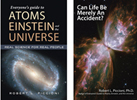|
July 19,
2010 Newsletter
Bad TV Science
My
mission is to provide Real Science for Real People—making real
discoveries and breakthrough ideas understandable to everyone without
“dumbing” them down. It’s a tough job. Others also try to do this, but
sometimes they do it very badly.
TV
has a lot of “science” shows. The ones I most enjoy are those featuring
spectacular videography of natural wonders, letting nature “speak” for
herself. The shows I like least are those that “explain” physics and
cosmology—Einstein, quantum mechanics, the Big Bang, string “theory”,
and so on. I feel obliged to watch, but find most of these shows
painful, akin to seeing a portrait of my grandmother done by Salvatore
Dali, with three eyes and two noses. I want to see the real person, not
sensationalized for commercial gain.
So
far, I am enjoying Morgan Freeman’s “Through the Wormhole”. But, in
general, TV science shows fail in three ways.
Firstly,
they often fail to translate science into English. Their scientists say
what but not why, and use professional jargon that no outsider
understands. Scientists don’t converse in normal English because
English lacks words for new phenomena. After decades of thinking and
speaking technical jargon, it’s very difficult for most scientists to
express their ideas in plain English—they just can’t do it.
Secondly,
TV narrators often say things that are complete nonsense—it’s clear
scientists rarely review the final cut. Take, for example, the
“explanation” of NASA’s WMAP measurements of the geometry of our
universe. The narrator said NASA shot lasers beams out to the ends of
the universe and measured the angles of the returning beams. That’s
complete rubbish. It has taken light 13.7 billion years to travel
one-way from “the edge” of the universe to earth. Even if someone were
holding up a mirror at the other end, a round-trip would take more than
27 billion years. Scientists made the first laser during my lifetime,
and I’m not nearly that old. An MIT professor then added that WMAP
proved the universe is “flat” and therefore infinite, with infinitely
many copies of you and me. Well ... maybe. The data actually prove the
universe is “flat” to 1% precision, and that is only within the small
portion of the universe that is observable. While 1% sounds good, Earth
can also look flat to 1% precision, but we know that isn’t true. In the
future, more precise measurements may show that the universe is
slightly curved, eventually closes in on itself, and is not infinite,
just like Earth. Marketable drama? Perhaps. Real science? NO.
That
brings us to the third major failing of TV science shows: they rarely
distinguish between pure speculation and validated theories. Crazy
ideas can be a good start, but until predictions are derived from these
ideas and are validated by multiple rigorous experiments, scientists do
not accept such ideas as credible. More than 99% of our best ideas turn
out to be wrong—not the way nature works. We must be skeptical of
unconfirmed ideas. Yet, TV often portrays many such speculations as
fact, saying for example that space has 7 dimensions we can’t see and
that there are an infinite number of parallel universes. The truth is
that there isn’t a shred of evidence confirming either.
TV
isn’t alone in delivering sensationalized, rather than real, science.
The front cover of July’s Scientific American proclaims: “The Universe
is Leaking...apparently breaking the laws of physics.” If you actually
read the article far enough, it eventually explains why this isn’t true
at all. What hype!
I
enjoy entertaining science fiction, but not when it masquerades as
science fact.
Best
Regards,
Robert
Author
of "Everyone's
Guide to Atoms, Einstein, and the Universe" and "Can
Life Be Merely An Accident?"

www.guidetothecosmos.com
|
|